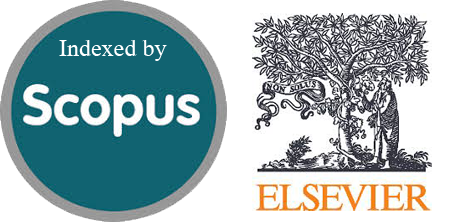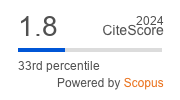Credit Scoring Model for Farmers using Random Forest
Abstract
One of the problems faced by farmers in Indonesia is capital. Based on Indonesian Central Statistics Agency survey results, the number of farmers who borrow capital from formal institutions such as banks is still small. This is because the process of applying for loans at banks is lengthy, farmers are considered high-risk and unbankable, and the rating of the agricultural sector is unattractive to banks. This study aims to determine the attributes and design a model of agricultural credit assessment. This study uses secondary data related to bank credit ratings and land productivity from banks in the Telagasari sub-district in 2018–2020 and Cipayung sub-district in 2020. Data were analyzed using random forests. The research process includes four stages: data collection, data pre-processing, model building, and model analysis and evaluation. This study produced five important variables that are relevant to farmers: planting costs, sales, land productivity, total production, and land area. The model built produces the most optimal accuracy of 83% with an AUC score of 81%. Based on the AUC performance classification, it can be concluded that the model that has been made is good at predicting the credit status of farmers because the AUC value is included in the good classification predicate.
Downloads
References
Ashari, “Optimalisasi Kebijakan Kredit Program Sektor Pertanian Di Indonesia,” Anal. Kebijak. Pertan., vol. 7, no. 1, pp. 21–42, 2016, doi: http://dx.doi.org/10.21082/akp.v7n1.2009.21-42.
BPS, Hasil Survei Struktur Ongkos Usaha Tanaman Holtikultura (SOUH) 2018. Jakarta: Badan Pusat Statistik Indonesia, 2018.
D. Pratiwi, M. Ambayoen, and A. Hardana, “Studi Pembiayaan Mikro Petani Dalam Pengambilan Keputusan Untuk Kredit Formal dan Kredit Nonformal,” HABITAT, vol. 30, no. 1, pp. 35–43, Apr. 2019, doi: 10.21776/ub.habitat.2019.030.1.5.
Safira, Bappenas, Australian Goverment, and Grow Asia, “Penilaian Kredit Digital di Sektor Pertanian: Praktik Terbaik Penilaian Risiko Kredit dalam Rantai Nilai,” 2018.
N. Wahyuni, “Penerapan Prinsip 5C Dalam Pemberian Kredit Sebagai Perlindungan Bank,” Lex J. Kaji. Huk. Keadilan, vol. 1, no. 1, 2017, doi: 10.25139/lex.v1i1.236.
O. Dengiz and M. Sağlam, “Determination of land productivity index based on parametric approach using GIS technique,” Eurasian J. Soil Sci., vol. 1, no. 1, pp. 51–57, 2012, doi: 10.18393/ejss.12237.
O. E. Emmanuel, N. C. Ehirim, E. . Eze, and M. N. Osuji, “Analysis Of Socio-Economic Variables On Agricultural Productivity Of Some Selected Arable Crops In Imo State. Nigeria,” vol. 16, no. 1, pp. 1385–1391, 2013.
T. Urgessa, “Review on the Determinants of Agricultural Productivity and Rural Household Income in Ethiopia,” Ethiop. J. Ecnomoucs, vol. 24, no. 2, 2015, doi: 10.7176/jesd/11-18-01.
Z. Khemais, D. Nesrine, and M. Mohamed, “Credit Scoring and Default Risk Prediction: A Comparative Study between Discriminant Analysis & Logistic Regression,” Int. J. Econ. Financ., vol. 8, no. 4, p. 39, 2016, doi: 10.5539/ijef.v8n4p39.
X. Zhang, Y. Yang, and Z. Zhou, “A novel credit scoring model based on optimized random forest,” in 2018 IEEE 8th Annual Computing and Communication Workshop and Conference (CCWC), Jan. 2018, pp. 60–65, doi: 10.1109/CCWC.2018.8301707.
Y. Fengge and W. Jing, “Agriculture microfinance risk control based on credit score model in China,” in 2013 6th International Conference on Information Management, Innovation Management and Industrial Engineering, Nov. 2013, pp. 316–320, doi: 10.1109/ICIII.2013.6703581.
C. Rao, M. Liu, M. Goh, and J. Wen, “2-stage modified random forest model for credit risk assessment of P2P network lending to ‘Three Rurals’ borrowers,” Appl. Soft Comput. J., vol. 95, p. 106570, 2020, doi: 10.1016/j.asoc.2020.106570.
S. Y. Sohn, D. H. Kim, and J. H. Yoon, “Technology credit scoring model with fuzzy logistic regression,” Appl. Soft Comput. J., vol. 43, pp. 150–158, 2016, doi: 10.1016/j.asoc.2016.02.025.
S. I. Hermawan and R. F. Malik, “Credit Scoring Menggunakan Algoritma Classification And Regression Tree (CART),” in Prosing Annual Research Seminar 2016, 2016, vol. 2, no. 1, pp. 82–85, [Online]. Available: http://ars.ilkom.unsri.ac.id.
H. Van Sang, N. H. Nam, and N. D. Nhan, “A novel credit scoring prediction model based on feature selection approach and parallel random forest,” Indian J. Sci. Technol., vol. 9, no. 20, 2016, doi: 10.17485/ijst/2016/v9i20/92299.
H. Xiao, Z. Xiao, and Y. Wang, “Ensemble classification based on supervised clustering for credit scoring,” Appl. Soft Comput. J., vol. 43, pp. 73–86, 2016, doi: 10.1016/j.asoc.2016.02.022.
C. Luo, D. Wu, and D. Wu, “A deep learning approach for credit scoring using credit default swaps,” Eng. Appl. Artif. Intell., vol. 65, no. September, pp. 465–470, Oct. 2016, doi: 10.1016/j.engappai.2016.12.002.
A. Bequé and S. Lessmann, “Extreme learning machines for credit scoring: An empirical evaluation,” Expert Syst. Appl., vol. 86, pp. 42–53, 2017, doi: 10.1016/j.eswa.2017.05.050.
F. Garunescu, Data Mining: Concepts and Techniques. Springers, 2011.
G. Haixiang, L. Yijing, J. Shang, G. Mingyun, and H. Yuanyue, “Learning from class-imbalanced data : Review of methods and applications,” Expert Syst. Appl., vol. 73, pp. 220–239, 2017, doi: 10.1016/j.eswa.2016.12.035.
A. S. More and D. P. Rana, “Review of random forest classification techniques to resolve data imbalance,” in 2017 1st International Conference on Intelligent Systems and Information Management (ICISIM), Oct. 2017, pp. 72–78, doi: 10.1109/ICISIM.2017.8122151.
M. M. Ramadhan, I. S. Sitanggang, F. R. Nasution, and A. Ghifari, “Parameter Tuning in Random Forest Based on Grid Search Method for Gender Classification Based on Voice Frequency,” in DEStech Transactions on Computer Science and Engineering, 2017, no. cece, doi: 10.12783/dtcse/cece2017/14611.
Copyright (c) 2023 Jurnal RESTI (Rekayasa Sistem dan Teknologi Informasi)

This work is licensed under a Creative Commons Attribution 4.0 International License.
Copyright in each article belongs to the author
- The author acknowledges that the RESTI Journal (System Engineering and Information Technology) is the first publisher to publish with a license Creative Commons Attribution 4.0 International License.
- Authors can enter writing separately, arrange the non-exclusive distribution of manuscripts that have been published in this journal into other versions (eg sent to the author's institutional repository, publication in a book, etc.), by acknowledging that the manuscript has been published for the first time in the RESTI (Rekayasa Sistem dan Teknologi Informasi) journal ;








